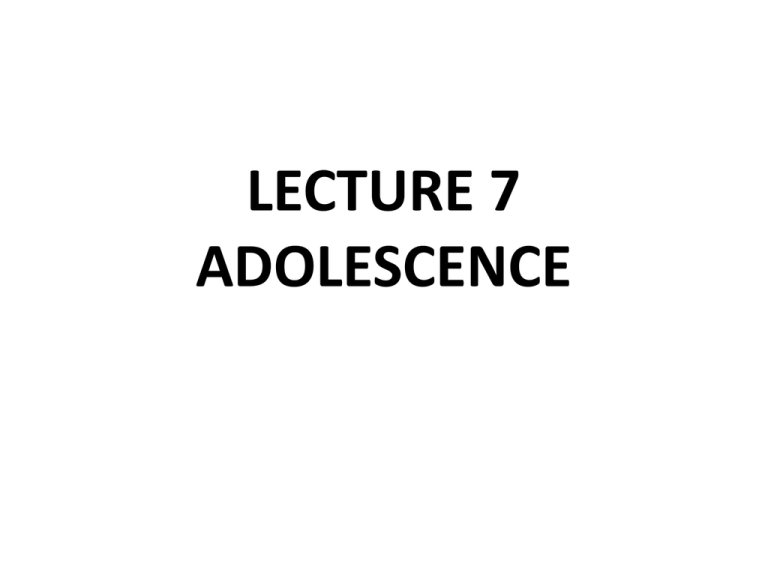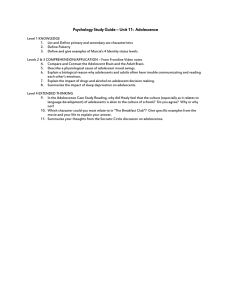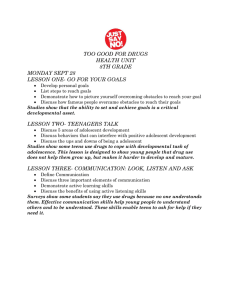LECTURE 7 ADOLESCENCE
advertisement

LECTURE 7 ADOLESCENCE OBJECTIVES • Define adolescence. • State the three phases of adolescence. • State the physiological changes that occur during adolescence. • Define puberty. • Identify the major developmental tasks of adolescence. • Discuss the adolescence's stage of development according to Erikson and Piaget. OBJECTIVES • Discuss the impact of peers, cliques, and best friends on the growth and development of the adolescence. • Discuss the role of dating in the development of cognitive and social behavior development. • Discuss the role of parents in fostering the positive growth and development of the adolescent. • Stat two specific health risks in the adolescent age group. • Discuss how to determine the fertile period of a female adolescent. • Definition • The origin of the word adolescence Is from the latin word adolesere, which means “to grow and mature”. • Adolescence is considered to be the bridge between childhood and adulthood. • lt is a unique stage of development characterized by many physiological cognitive psychosocial and sexual changes. • The health habits and coping skills fromed during this period last for a lifetime and mastery of developmental tasks during this period helps prepare the adolescent for adulthood Developmental tasks • Developmental tasks Encountered during adolescence include: 1-Establishing a stabilized sense of identity 2 -Separation from family career planning 3 -Establishing close peer relationships 4 -intimacy. • Adolescence is often separated into three phases 1 -Early adolescence (10 to13 years). 2 -Middle adolescence (14 to16 years). 3 -Late adolescence (17 to 20 years). Physiological changes • The 13 year old adolescent differs greatly from the 18 year old adolescent each of these three distinct phases of adolescence has its own set of challenges • Early adolescence also called preadolescence is characterized by physical changes in the structure and function of various parts of the body. • Weight gain is common and the major cause is an increase in musculoskeletal mass. • Growth is asynchronous, which means different parts of the body mature at different times, possibly resulting in temporary awkward appearance . • Growth sput occurs during adolescence. Three Phases of Growth and Development of the Adolescent Early (10 to13years) Middle (14 to 16 years) Late (17 to 20 years) Physical growth Appearance of secondary Spurt in height sex characteristics growth Growth slows Body image Self-conscious adjusts to pubertal changes Experiments with different images and looks Accepts body image personality emerges self-concept Low self –esteem Denial of reality Impulsive Impatient Identify confusion Has positive Self-image Empathetic Independent thinker Behavior Behaves for rewards Behaves to conform Shows responsible Behavior Peers Unisex cliques of friends Has best friend Engages in hero worship Has adult crushes Begins dating Has need to please significant peer Develops heterosexual peer group Values individual relationships Begins partner selection Family Is ambivalent to family Strives for independence Struggles for autonomy and acceptance Rebels /withdraws Demands privacy Achieves in dependence Reestablishes family relationships Cognitive Concrete development thinking Here and now is important Early abstract Abstract Daydreams thinking fantasizes Idealistic Starts inductive and deductive reasoning Goals Identifies/skills interests Becomes a super achiever or dropout. Socializing is priority Goals may be unrealistic Identifies career goals Enter work or college Health concerns Concerned about normalcy Concerned about experimenting with drugs or sex Idealistic Decision making for life style choice Interventions Coveys limits Encourage Verbalization Help them solve problems from choices Use peer group sessions Provide privacy Discuss goals Allow participation in decisions Provide confidentiality Puberty • The word puberty refers to sexual maturity or Having the functional ability to reproduce. • Puberty involves physical and psychological changes. boys • For boys, puberty begins between 10 and 13 years with normal changes. • Secondary sex characteristics are not involved in the reproductive process but appear at this time. • Increases in androgens are responsible for producing the male secondary sex characteristics . Girls • For girls during puberty, hormone begin establish a pattern within a monthly cycle. This pattern can typically be 28 to 32 days apart. • The very first menstrual period is called the menarche. • The menarche usually occurs between age 12 and 13 but can occur between 10 and 15. Cognitive Development • According to Piaget young adolescents are in the concrete phase of thinking which means they interpret words and concepts literally. • By middle adolescence they begin to think more abstractly. • This stage of cognitive development is called the fromal operation stage. • Adolescents in this stage can process information quickly and efficiently and their thinking becomes more complex. Psychosocial development • According to Erikson one of the major tasks of adolescence is achieving a stable self identity. • Adolescent may try out various temporary styles and social roles in the process of finding their own individual identity. Teen Violence • The united status rates highest in the industrial world in violent death rate. • Violent crimes involving teenagers are an increasing problems. • Children in Adolescents often use violence to handle conflicts. DEVELOPMENT OF RESPONSIBILTY • Adolescents look forward to challenges and often feel humiliated when placed in the dependent role. • It is important for the adolescent to be responsible for making decisions, especially those relative to career, politics, and religion. • The role of parents should be listening and guiding the adolescent rather than mandating behavior. Peer relationships • Peer group affiliation has a major impact on a dorescent growth and development. • school plays an important role in psychosocial development because it provides the opportunity for social interaction peer group association and clique formation. Teaching techniques for the adolescent • The first step in effectively teaching adolescents involves establishing trusting relationship communication must be supportive and not threaten • Identifying health risks of the adolescent is essential to plan teaching relevant to preventative health care • Health conditions that benefit from preventative measures and early intervention include substances abuse and depression. • Motor vehicle accidents(MVAs) continue to be the leading cause of teen morbidity and mortality and are preventable with appropriate education and training. Thank You





